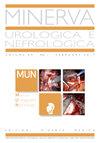Artifacts and abnormal findings may limit the use of asymptomatic volunteers as controls for studies of multi-channel urodynamics.
Q1 Medicine
引用次数: 3
Abstract
BACKGROUND Multi-channel urodynamics is the gold-standard for the evaluation of LUTS. When performing studies to validate new adjuncts to urodynamic testing with control patients undergoing urodynamic investigation there is difficulty in interpretation of urodynamic results in the asymptomatic patient due to artifacts and the invasive nature of the procedure. The purpose of this investigation was to examine urodynamics in asymptomatic volunteers in order to better understand the role of control participants in urodynamic research studies. METHODS Asymptomatic volunteers with no LUTS were recruited to undergo standard urodynamic testing as a comparison group in a study evaluating novel urodynamic techniques. To be eligible, participants had to report no LUTS, score ≤1 on all symptom questions of the ICIq-OAB survey, have no medical conditions or be on any medications that affect bladder function. The urodynamics was done according to ICS standards. All tracings were evaluated by an expert neuro-urologist. Data were analyzed categorically for the presence or absence of low compliance (< 30ml/cmH20), detrusor overactivity, bladder outlet obstruction (BOOI > 40), weak contractility (BCI < 100), straining to void, poorly sustained detrusor contraction, uncoordinated EMG activity, and intermittent flow. RESULTS A total of 24 participants completed the study including 10 men and 14 women. All participants had at least 1 urodynamic abnormality/artifact with an average of 4.43±1.28 abnormalities/participant. The most common abnormalities included uncoordinated EMG activity (87.50%), straining to void (79.17%), and intermittent flow (70.83%). There were no significant differences for sex, age, BMI. CONCLUSIONS This study demonstrated that healthy, asymptomatic volunteers have high rates of abnormal urodynamic findings, suggesting that asymptomatic participants are not the ideal controls in research studies that involve urodynamic testing.伪影和异常发现可能限制无症状志愿者作为多通道尿动力学研究的对照。
背景:多通道尿动力学是评价LUTS的金标准。在对接受尿动力学检查的对照患者进行研究以验证尿动力学检查的新辅助手段时,由于伪影和手术的侵入性,在解释无症状患者的尿动力学结果时存在困难。本研究的目的是检查无症状志愿者的尿动力学,以便更好地了解对照组参与者在尿动力学研究中的作用。方法在一项评估新型尿动力学技术的研究中,招募无LUTS症状的志愿者进行标准尿动力学测试作为对照组。入选条件为:受试者报告无LUTS, ICIq-OAB调查的所有症状问题得分≤1分,无医疗状况或正在服用任何影响膀胱功能的药物。尿动力学按照ICS标准进行。所有的追踪都由神经泌尿科专家进行评估。数据分类分析是否存在低顺应性(< 30ml/cmH20)、逼尿肌过度活动、膀胱出口梗阻(BOOI > 40)、收缩力弱(BCI < 100)、用力排空、逼尿肌收缩持续性差、肌电活动不协调和间歇性血流。结果共有24名参与者完成了研究,其中男性10名,女性14名。所有参与者至少有1个尿动力学异常/伪影,平均4.43±1.28个异常/参与者。最常见的异常包括不协调的肌电活动(87.50%),紧张排空(79.17%)和间歇性血流(70.83%)。性别、年龄和体重指数没有显著差异。结论:本研究表明,健康、无症状的志愿者尿动力学异常的发生率很高,这表明无症状的参与者并不是涉及尿动力学测试的研究的理想对照。
本文章由计算机程序翻译,如有差异,请以英文原文为准。
求助全文
约1分钟内获得全文
求助全文
来源期刊

Minerva Urologica E Nefrologica
UROLOGY & NEPHROLOGY-
CiteScore
5.50
自引率
0.00%
发文量
0
审稿时长
>12 weeks
期刊介绍:
The journal Minerva Urologica e Nefrologica publishes scientific papers on nephrology and urology. Manuscripts may be submitted in the form of Minerva opinion editorials, editorial comments, original articles, video illustrated articles, review articles and letters to the Editor.
 求助内容:
求助内容: 应助结果提醒方式:
应助结果提醒方式:


